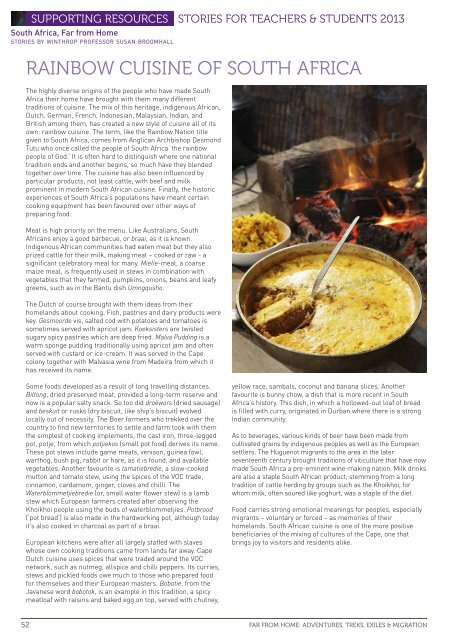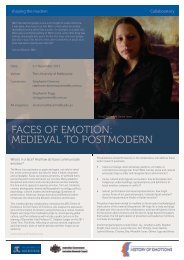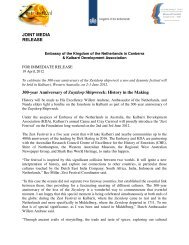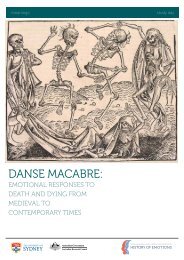Download our K-12 education pack - ARC Centre of Excellence for ...
Download our K-12 education pack - ARC Centre of Excellence for ...
Download our K-12 education pack - ARC Centre of Excellence for ...
You also want an ePaper? Increase the reach of your titles
YUMPU automatically turns print PDFs into web optimized ePapers that Google loves.
Supporting Res<strong>our</strong>ces stories <strong>for</strong> teachers & students 2013<br />
South Africa, Far from Home<br />
stories by winthrop pr<strong>of</strong>essor susan broomhall<br />
Rainbow Cuisine <strong>of</strong> South Africa<br />
The highly diverse origins <strong>of</strong> the people who have made South<br />
Africa their home have brought with them many different<br />
traditions <strong>of</strong> cuisine. The mix <strong>of</strong> this heritage, indigenous African,<br />
Dutch, German, French, Indonesian, Malaysian, Indian, and<br />
British among them, has created a new style <strong>of</strong> cuisine all <strong>of</strong> its<br />
own: rainbow cuisine. The term, like the Rainbow Nation title<br />
given to South Africa, comes from Anglican Archbishop Desmond<br />
Tutu who once called the people <strong>of</strong> South Africa ‘the rainbow<br />
people <strong>of</strong> God.’ It is <strong>of</strong>ten hard to distinguish where one national<br />
tradition ends and another begins, so much have they blended<br />
together over time. The cuisine has also been influenced by<br />
particular products, not least cattle, with beef and milk<br />
prominent in modern South African cuisine. Finally, the historic<br />
experiences <strong>of</strong> South Africa’s populations have meant certain<br />
cooking equipment has been fav<strong>our</strong>ed over other ways <strong>of</strong><br />
preparing food.<br />
Meat is high priority on the menu. Like Australians, South<br />
Africans enjoy a good barbecue, or braai, as it is known.<br />
Indigenous African communities had eaten meat but they also<br />
prized cattle <strong>for</strong> their milk, making meat – cooked or raw - a<br />
significant celebratory meal <strong>for</strong> many. Mielie-meal, a coarse<br />
maize meal, is frequently used in stews in combination with<br />
vegetables that they farmed, pumpkins, onions, beans and leafy<br />
greens, such as in the Bantu dish Umngqusho.<br />
The Dutch <strong>of</strong> c<strong>our</strong>se brought with them ideas from their<br />
homelands about cooking. Fish, pastries and dairy products were<br />
key. Gesmoorde vis, salted cod with potatoes and tomatoes is<br />
sometimes served with apricot jam. Koeksisters are twisted<br />
sugary spicy pastries which are deep fried. Malva Pudding is a<br />
warm sponge pudding traditionally using apricot jam and <strong>of</strong>ten<br />
served with custard or ice-cream. It was served in the Cape<br />
colony together with Malvasia wine from Madeira from which it<br />
has received its name.<br />
Some foods developed as a result <strong>of</strong> long travelling distances.<br />
Biltong, dried preserved meat, provided a long-term reserve and<br />
now is a popular salty snack. So too did droëwors (dried sausage)<br />
and beskuit or rusks (dry biscuit, like ship’s biscuit) evolved<br />
locally out <strong>of</strong> necessity. The Boer farmers who trekked over the<br />
country to find new territories to settle and farm took with them<br />
the simplest <strong>of</strong> cooking implements, the cast iron, three-legged<br />
pot, potje, from which potjiekos (small pot food) derives its name.<br />
These pot stews include game meats, venison, guinea fowl,<br />
warthog, bush pig, rabbit or hare, as it is found, and available<br />
vegetables. Another fav<strong>our</strong>ite is tamatiebredie, a slow-cooked<br />
mutton and tomato stew, using the spices <strong>of</strong> the VOC trade,<br />
cinnamon, cardamom, ginger, cloves and chilli. The<br />
Waterblommetjiebredie (or, small water flower stew) is a lamb<br />
stew which European farmers created after observing the<br />
Khoikhoi people using the buds <strong>of</strong> waterblommetjies. Potbrood<br />
(‘pot bread’) is also made in the hardworking pot, although today<br />
it’s also cooked in charcoal as part <strong>of</strong> a braai.<br />
European kitchens were after all largely staffed with slaves<br />
whose own cooking traditions came from lands far away. Cape<br />
Dutch cuisine uses spices that were traded around the VOC<br />
network, such as nutmeg, allspice and chilli peppers. Its curries,<br />
stews and pickled foods owe much to those who prepared food<br />
<strong>for</strong> themselves and their European masters. Bobotie, from the<br />
Javanese word bobotok, is an example in this tradition, a spicy<br />
meatloaf with raisins and baked egg on top, served with chutney,<br />
yellow race, sambals, coconut and banana slices. Another<br />
fav<strong>our</strong>ite is bunny chow, a dish that is more recent in South<br />
Africa’s history. This dish, in which a hollowed-out loaf <strong>of</strong> bread<br />
is filled with curry, originated in Durban where there is a strong<br />
Indian community.<br />
As to beverages, various kinds <strong>of</strong> beer have been made from<br />
cultivated grains by indigenous peoples as well as the European<br />
settlers. The Huguenot migrants to the area in the later<br />
seventeenth century brought traditions <strong>of</strong> viticulture that have now<br />
made South Africa a pre-eminent wine-making nation. Milk drinks<br />
are also a staple South African product, stemming from a long<br />
tradition <strong>of</strong> cattle herding by groups such as the Khoikhoi, <strong>for</strong><br />
whom milk, <strong>of</strong>ten s<strong>our</strong>ed like yoghurt, was a staple <strong>of</strong> the diet.<br />
Food carries strong emotional meanings <strong>for</strong> peoples, especially<br />
migrants – voluntary or <strong>for</strong>ced – as memories <strong>of</strong> their<br />
homelands. South African cuisine is one <strong>of</strong> the more positive<br />
beneficiaries <strong>of</strong> the mixing <strong>of</strong> cultures <strong>of</strong> the Cape, one that<br />
brings joy to visitors and residents alike.<br />
52 FAR FROM HOME: ADVENTURES, TREKS, EXILES & MIGRATION












